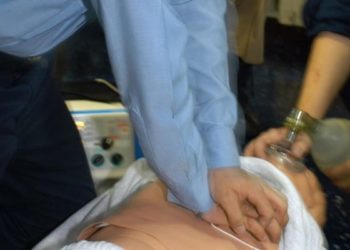Quality improvement initiatives improve ventilation during pediatric cardiopulmonary resuscitation
1. Quality improvement (QI) initiatives that included bedside provider education, CPR leader education and feedback, and ventilation-focused CPR tools reduced hyperventilation time during pediatric CPR events from 51% to 31%.
Evidence Rating Level: 2 (Good)
Study Rundown: High quality cardiopulmonary resuscitation (CPR) improves outcomes in cardiac arrest scenarios. One component of high-quality CPR is avoiding excessive ventilation (>30 breaths/min) that may lower survival rates by decreasing venous return and coronary perfusion. An initial retrospective chart review of three pediatric intensive care units in New York found that there was clinically significant hyperventilation during 51% of CPR time. Following interviews with practitioners and stakeholders, this study aimed to lower the time with hyperventilation from 51% to 30% by implementing the following interventions: (1) bedside provider education, (2) CPR leader education and feedback, and (3) ventilation-focused CPR tools. In the study timeframe between 2016 and 2018, 37 CPR events pre-intervention and 24 CPR events post-intervention met inclusion criteria for analysis. Following intervention, the proportion of hyperventilation time during CPR dramatically decreased from 51% to 29% with a significant decrease in the median ventilation rate from 30 bpm to 21 bpm. An important limitation of this study is that a substantial number of cardiac arrests (~30%) were excluded due to a lack of end-tidal carbon dioxide (ETCO2). Further studies are required to address the utility of these quality improvement initiatives in other hospital settings.
Click here to read the article in PEDIATRICS
In Depth [retrospective cohort]: A retrospective chart review of CPR events was performed between April 2016 and December 2018 to provide an estimate of hyperventilation rates at baseline prior to quality improvement initiative. Interviews with stakeholders identified areas that contributed to hyperventilation including knowledge deficit, cognitive overload, and lack of resuscitation team buy in. Beside provider education was targeted to respiratory therapists and PICU nursing, and more specifically included structured sessions for beside providers, monthly meetings with practice councils, monthly presentations at the respiratory therapist huddles. CPR leader education and feedback was aimed at PICU fellows and attending physicians and included monthly quality meetings with review of primary outcomes with standardized debriefing tool and ventilation-focused feedback with ETCO2 tracing review. Ventilation focused tools to address cognitive overload included mobile applications with CPR metronomes, pre-procedural pocket cards and handbooks, and tasking respiratory therapists to use ETCO2 during CPR to provide real-time feedback for ventilation rates. Following the quality improvement interventions, the proportion of hyperventilation time during CPR dramatically decreased from 51% to 29% (95% CI 16% to 28%, p<0.001). The median ventilation rate decreased from 30 bpm (IQR 21- 36) to 21 bpm (IQR 12 – 30) after the implementation of the abovementioned initiatives (p<0.001).
Image: PD
©2022 2 Minute Medicine, Inc. All rights reserved. No works may be reproduced without expressed written consent from 2 Minute Medicine, Inc. Inquire about licensing here. No article should be construed as medical advice and is not intended as such by the authors or by 2 Minute Medicine, Inc.






![ABCD2 Score: Predicting Early Stroke Risk After Transient Ischemic Attack (TIA) [Classics Series]](https://www.2minutemedicine.com/wp-content/uploads/2013/05/web-cover-classics-with-logo-medicine-BW-small-jpg-75x75.jpg)


